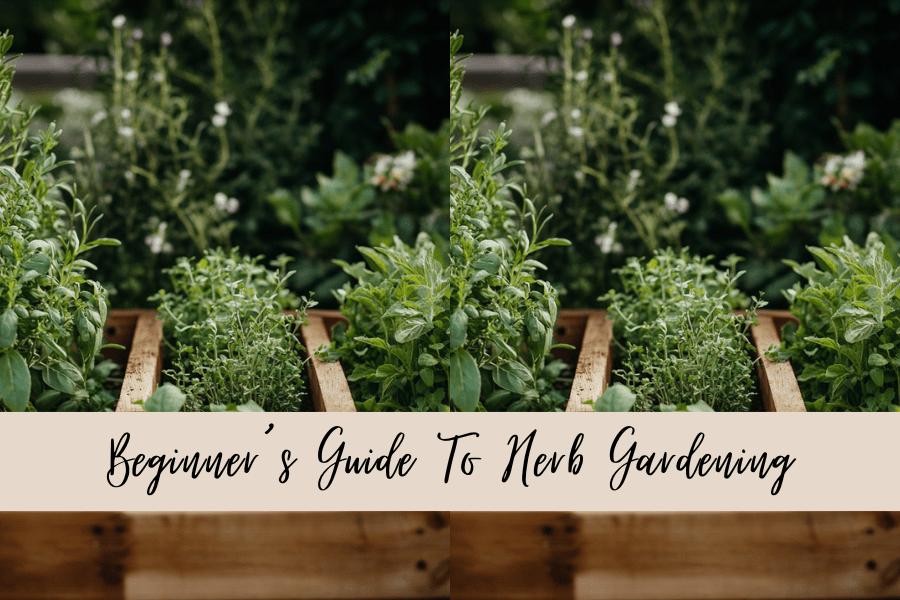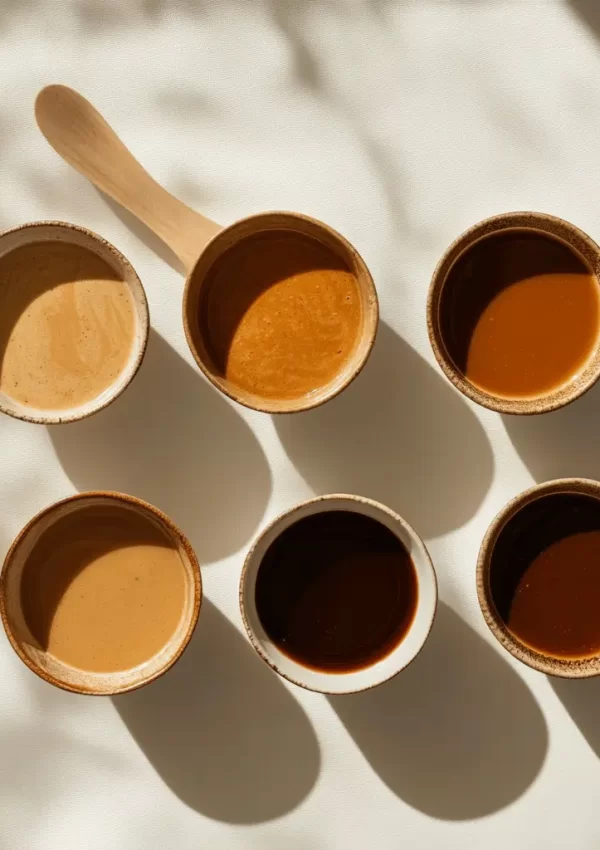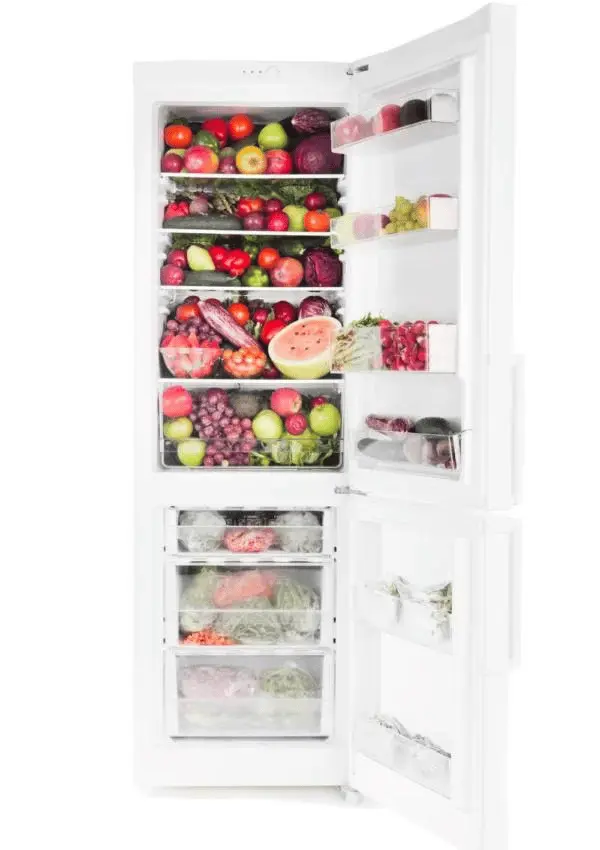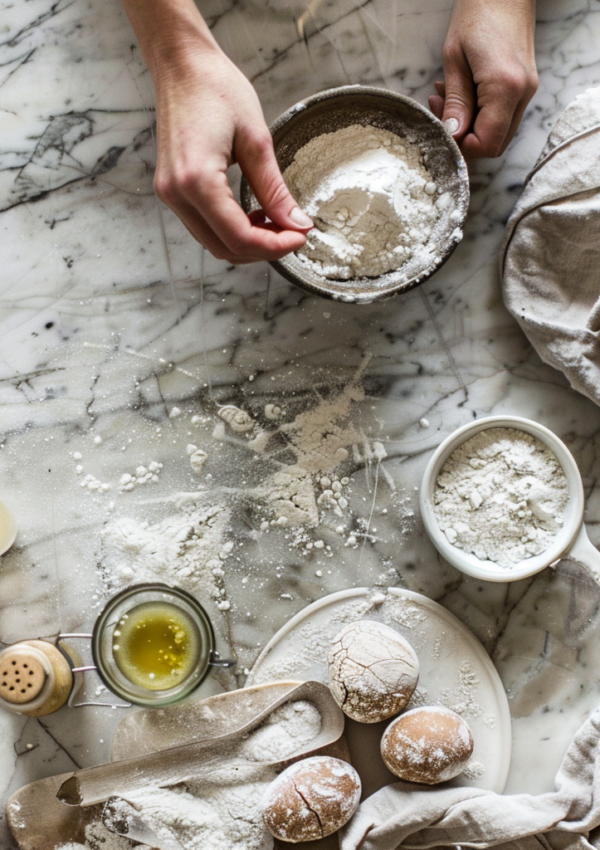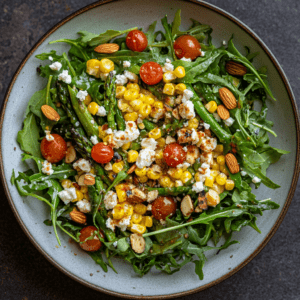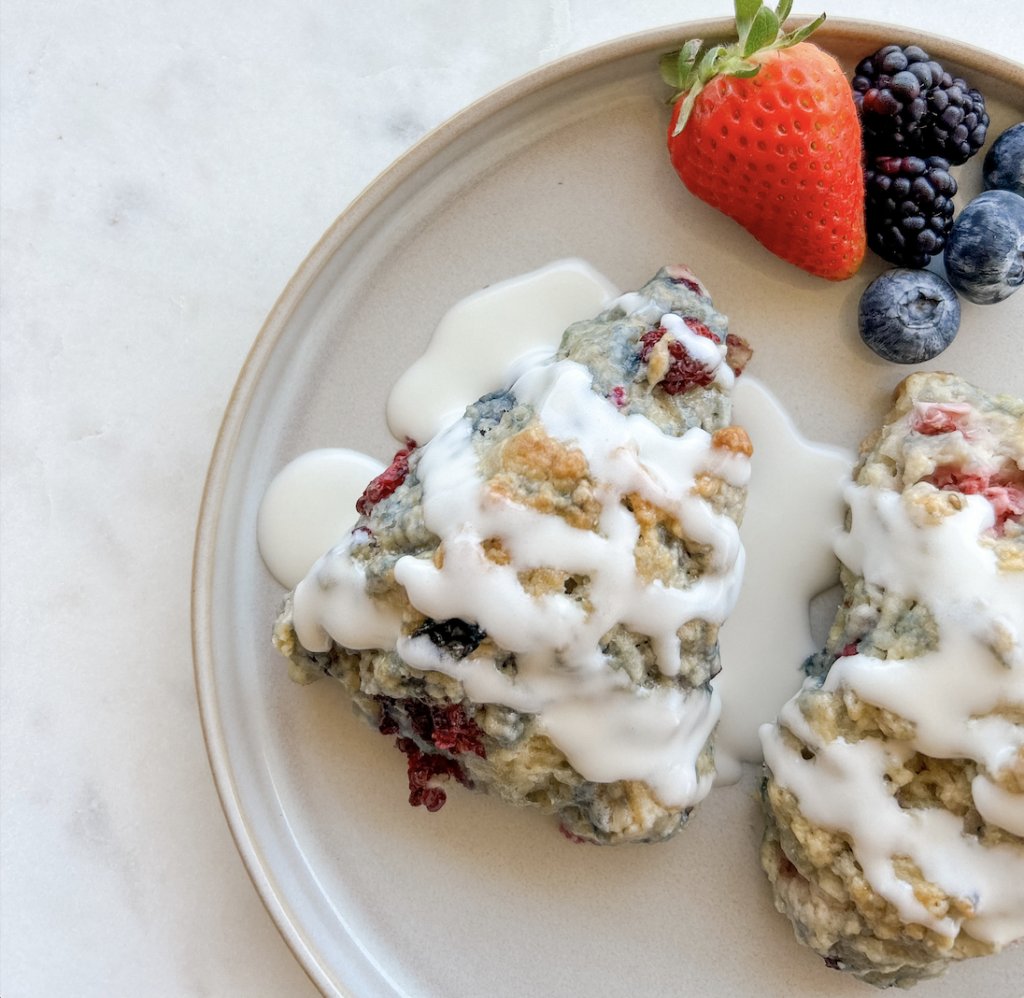This post contains affiliate links, which means I’ll receive a commission if you purchase through my link, at no extra cost to you. Please read the full disclosure here.
If you’ve ever dreamed of stepping outside your kitchen to snip a few sprigs of fresh basil or rosemary for your dinner—this post is for you.
I’m going to be honest with you: I do not naturally have a green thumb. I’ve killed more than a few succulents in my time, and every plant I’ve ever named has met a tragic end. But one of my big goals for 2025 is to finally grow something edible—and actually keep it alive. Specifically, I’m starting with a culinary herb garden, and I’m using this blog post as my own personal guide to do it.
Herbs are a great starting point for beginner gardeners like me. They’re low-maintenance, space-friendly, and endlessly useful in the kitchen. By growing my own, I’ll save money, cut down on waste, and have fresh herbs right when I need them—no last-minute grocery runs, and no more of those sad little plastic clamshells wilting in my fridge.
Whether you’ve got a sprawling backyard or just a sunny kitchen windowsill, this guide will walk you through everything you need to know to start and maintain your first herb garden—from choosing your plants to harvesting like a pro.
This post is all about how to grow a culinary herb garden.
Why Grow an Herb Garden?
Even if you’re brand-new to gardening, herbs are the perfect place to start. Here’s why:
-
Saves money: No more $3 clamshells that turn to mush in the fridge. You’ll get weeks—if not months—of fresh herbs from just one plant.
-
Instant flavor boost: Fresh herbs can completely transform a simple dish. Think scrambled eggs with chives, grilled chicken with rosemary, or fresh parsley on pasta.
-
Reduces waste: Cut what you need, when you need it.
-
Small-space friendly: You don’t need a backyard—many herbs thrive in pots, on patios, or in sunny windows.
-
Relaxing + therapeutic: Gardening is a great way to de-stress, get your hands in the soil, and spend time outdoors.
-
Encourages home cooking: When you’ve got fresh herbs on hand, it’s easier (and more fun) to cook at home.
What Are the Best Culinary Herbs to Grow?
There are dozens of herbs out there, but here are 12 of the most popular culinary herbs—including the best picks for beginners.
Top 12 Culinary Herbs:
-
Basil – Great for pesto, pasta, salads, and grilled veggies
-
Parsley – Versatile, adds freshness to everything from soups to grain bowls
-
Cilantro – Great for tacos, salsas, and Southeast Asian dishes (but bolts in heat!)
-
Mint – Excellent in drinks, salads, sauces, and desserts—but grows aggressively
-
Rosemary – Woodsy, aromatic herb for roasting and grilling
-
Thyme – Earthy and subtle, works with poultry, potatoes, and sauces
-
Oregano – Bold, punchy flavor that thrives in hot weather
-
Chives – Mild oniony flavor, amazing on eggs, potatoes, and creamy dips
-
Dill – Feathery, fragrant herb perfect for fish and pickling
-
Sage – Savory, cozy flavor, ideal in fall dishes and stuffing
-
Green Onion (Scallions) – Mild onion flavor with a slight peppery kick; perfect for salads, soups, stir-fries, and as a garnish.
-
Lemongrass – Tropical herb for Thai and Vietnamese cooking (grow in warm climates)
Best Herbs for Beginners:
-
Chives
-
Mint (in containers only!)
-
Basil
-
Parsley
-
Thyme
-
Oregano
- Green Onion (Scallions)
When Should You Start an Herb Garden?
Spring is the best time to start your herb garden—once the risk of frost has passed. Depending on where you live, this could be anywhere from March to May.
If you’re eager, you can start some herbs indoors in late winter and move them outside later. Many herbs can also be grown indoors year-round with enough light.
Where Should You Grow Your Herbs?
You’ve got options! Herbs are flexible and don’t need much space.
Planting Options:
-
Raised outdoor bed: (This is what I’m doing this year!) I’m using a raised garden bed with compartments for each herb.
-
Containers or pots: Perfect for patios, balconies, or front steps.
-
Kitchen window: A sunny windowsill is ideal for herbs like basil, chives, or parsley.
-
Hanging planters or wall gardens: Great for vertical gardening in small spaces.
Pro tip: Herbs need 6–8 hours of sunlight a day. South-facing locations work best.
The Best Herb Garden Layout
Whether you’re planting in a bed or a few pots, layout matters!
-
Group herbs with similar watering needs
-
Keep aggressive growers (like mint) in separate containers
-
Label everything—trust me, parsley and cilantro look the same at first
-
Put taller herbs in the back (rosemary, sage), shorter ones in front (thyme, chives)
If you’re using a raised bed like I am, you can dedicate one small square or section to each herb.
How to Grow Each Herb (Beginner-Friendly Tips)
Here’s a quick guide to growing and caring for each herb:
1. Basil
-
How to Plant: Start from seed indoors or plant seedlings once temperatures stay above 50°F. Loves warmth!
-
Sunlight: Full sun (6–8 hours).
-
Watering: Keep the soil consistently moist, but not soggy.
-
Harvesting Tip: Pinch off the top few sets of leaves regularly to keep it from flowering and to encourage bushy growth.
My Note: At my grocery store, fresh basil is always sold out. This one is top of my list to grow so I can stop fighting for it every week.
2. Mint
-
How to Plant: Plant in pots only! It spreads aggressively in beds.
-
Sunlight: Partial shade to full sun.
-
Watering: Likes moist soil—don’t let it dry out.
-
Harvesting Tip: Snip the stems often to prevent flowering and encourage full, fragrant leaves.
Pro Tip: Great for teas, mojitos, and fresh salads. You’ll never run out.
3. Parsley
-
How to Plant: Start from seed (soak overnight to help germinate) or buy a seedling.
-
Sunlight: Full sun to part shade.
-
Watering: Keep soil evenly moist.
-
Harvesting Tip: Cut outer stems first and let inner ones keep growing.
Why It’s Great: Super versatile and hardy—plus, it’s a natural breath freshener!
4. Cilantro
-
How to Plant: Direct sow in cool weather. It doesn’t transplant well.
-
Sunlight: Full sun.
-
Watering: Keep soil consistently moist.
-
Harvesting Tip: Harvest leaves when the plant is 4–6 inches tall; it bolts quickly in heat.
Beginner Alert: Plant a new batch every 2–3 weeks in early spring for a steady supply.
5. Thyme
-
How to Plant: Buy a starter plant or rooted cutting—slow to grow from seed.
-
Sunlight: Full sun.
-
Watering: Drought-tolerant. Let the soil dry between waterings.
-
Harvesting Tip: Snip stems close to the base—avoid cutting the woody parts.
Why I Love It: Tiny leaves, huge flavor. Adds depth to roasted veggies and meats.
6. Chives
-
How to Plant: Grow from seed, division, or transplant. They’re very beginner-friendly.
-
Sunlight: Full to partial sun.
-
Watering: Keep soil moist but well-drained.
-
Harvesting Tip: Snip at the base when they reach about 6 inches. They grow back fast!
Bonus: The edible purple flowers are so pretty in salads.
7. Oregano
-
How to Plant: Start from a seedling or cutting.
-
Sunlight: Full sun.
-
Watering: Water moderately; it doesn’t like soggy soil.
-
Harvesting Tip: Trim often to prevent flowering. Use fresh or dry for later.
Caution: It spreads quickly—give it some space or plant in a pot.
8. Rosemary
-
How to Plant: Best to buy a small plant—it’s slow from seed.
-
Sunlight: Full sun.
-
Watering: Let the soil dry completely between waterings.
-
Harvesting Tip: Snip the top stems as needed; don’t overharvest woody parts.
Kitchen Favorite: Great for roasting and makes your whole garden smell amazing.
9. Sage
-
How to Plant: Start from a small plant.
-
Sunlight: Full sun.
-
Watering: Prefers drier soil. Water when the top inch feels dry.
-
Harvesting Tip: Pick a few leaves at a time. Once established, it gets bushy fast!
Pro Tip: Sage + browned butter = magic on pasta or roasted squash.
10. Dill
-
How to Plant: Direct sow into soil. Doesn’t like to be transplanted.
-
Sunlight: Full sun.
-
Watering: Keep soil evenly moist.
-
Harvesting Tip: Use the leafy fronds early; let some plants flower for dill seeds later.
Bonus: Attracts beneficial insects like butterflies and ladybugs!
11. Green onion (scallions)
-
How to Plant: Start from seed, transplants, or even root ends of store-bought scallions—just place in water until roots grow, then plant in soil.
-
Sunlight: Full sun to partial shade.
-
Watering: Keep soil moist but not waterlogged.
-
Harvesting Tip: Snip the green tops as needed, or pull the whole plant when bulbs are mature. You can regrow from the white root base!
Bonus: Perfect for kitchen windowsills—super low-maintenance and regrows fast.
12. Lemongrass
-
How to Plant: Buy a stalk with a root bulb and place in water to root, then plant.
-
Sunlight: Full sun and heat.
-
Watering: Water often—this one’s thirsty!
-
Harvesting Tip: Cut stalks from the base once they’re thick. Use the bottom 5 inches for cooking.
My Note: A total flavor bomb for soups and stir-fries—worth the effort!
Supplies You’ll Need
Here’s what I bought for my first official herb garden:
Tips to Keep Your Herbs Alive
-
Water consistently: Most herbs prefer evenly moist soil—but not soggy. Check before watering.
-
Harvest often: Snipping herbs encourages bushier growth and prevents flowering.
-
Watch the sun: If your herbs aren’t thriving, they may need more direct light.
-
Feed occasionally: Compost tea or diluted organic fertilizer every few weeks does the trick.
-
Pest control: Neem oil or insecticidal soap can help, but herbs tend to be low-maintenance!
Common Herb Gardening Questions (Quick Answers!)
Q: Which herbs should not be planted together?
A: Avoid planting mint or fennel with others—they’re space hogs and can stunt nearby plants.
Q: Which herb grows out of control?
A: Mint. Always, always grow it in its own container.
Q: What’s the hardest herb to grow?
A: Cilantro—it bolts quickly in heat. Tarragon can also be tricky in warmer climates.
Q: Which herbs repel bugs?
A: Basil, mint, rosemary, lavender—bonus: they smell amazing, too.
Q: Which herbs clean the air?
A: Parsley, basil, and rosemary help purify indoor air and reduce toxins.
You May Also Like
If you liked this guide, you may also like:
- The Ultimate Guide to Storing Fresh Herbs
- Tips For Making Perfectly Cooked Grains
- How To Cook Perfectly Al Dente Pasta Everytime
OR browse through my entire Kitchen Tips Category here.
Let’s Grow Together
I’ll be honest—this guide is as much for me as it is for you. I’m determined to make this the year I finally grow a lush, thriving herb garden… and I hope you’ll join me!
If you’re also starting from scratch, let me know what you’re planting and where. Or if you’ve done this before, leave your best tips in the comments—because I need all the help I can get.
Here’s to fresh herbs, flavorful meals, and growing something we can be proud of! 🌿
This post was all about how to grow a culinary herb garden.
Growing your first culinary herb garden? Make sure to tag me @thespicegirlkitchen_ on Instagram or @thespicegirlkitchen on TikTok! I love seeing you CRUSH IT! I will be your ultimate hype woman!
Want to learn more about Kelsey? Click here to read her story!

